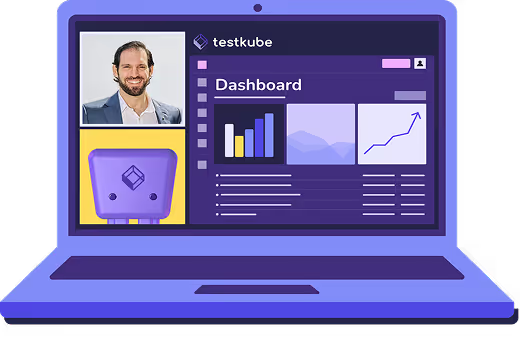Table of Contents
What Does Distributed Testing Mean?
As test suites expand, running them sequentially becomes inefficient and costly. Distributed testing solves this by splitting workloads across machines, nodes, or clusters, reducing runtime and enabling enterprise-scale validation.
Distributed testing is a software testing methodology that executes test cases simultaneously across multiple computing resources rather than running them one after another on a single machine. This approach is essential for modern development teams dealing with comprehensive test suites that would otherwise take hours or even days to complete. By leveraging parallel execution across distributed infrastructure, teams can maintain rapid development cycles while ensuring thorough quality assurance coverage.
The core principle behind distributed testing involves partitioning test workloads into smaller, independent segments that can run concurrently without interfering with each other. This parallelization dramatically reduces overall test execution time, accelerates feedback loops, and enables teams to run more tests more frequently, a critical capability for organizations practicing continuous integration and continuous delivery (CI/CD).
Architecture Components of Distributed Testing
A typical distributed testing architecture includes several key components working together:
- Controller nodes orchestrate test execution, manage job distribution, schedule workloads, and monitor overall system health. These nodes act as the brain of the distributed system, determining how tests should be allocated and ensuring efficient resource utilization.
- Worker nodes execute test subsets independently, process assigned test cases, and report results back to the controller. Worker nodes can scale horizontally based on demand, allowing the system to handle varying workload sizes.
- Result aggregation systems collect and analyze outcomes from all worker nodes, consolidate test reports, identify failures, and provide unified dashboards for team visibility. These systems transform distributed data into actionable insights.
- Communication mechanisms coordinate distributed workloads through message queues, service meshes, or direct network protocols. Reliable communication ensures test orchestration remains synchronized even when spanning multiple data centers or cloud regions.
Modern implementations rely on container orchestration platforms like Kubernetes, cloud infrastructure from providers like AWS, Azure, or GCP, and intelligent test distribution algorithms to scale efficiently. These technologies enable dynamic resource allocation, automatic failover, and optimal test scheduling based on historical performance data.
Why It Matters
Distributed testing is critical for organizations aiming to maintain velocity without sacrificing quality:
- Running large regression suites quickly allows comprehensive test suites with thousands of test cases to execute in minutes instead of hours, enabling multiple test runs per day and faster release cycles.
- Supporting performance and load tests at scale requires simulating thousands or millions of concurrent users with distributed infrastructure to generate realistic load patterns and measure system behavior under stress.
- Reducing CI/CD bottlenecks with parallelized execution eliminates testing as a sequential constraint, keeping deployment pipelines moving and preventing quality gates from slowing down releases.
- Ensuring fault tolerance by isolating workloads across nodes means that if one worker node fails, other nodes continue executing their assigned tests, preventing single points of failure from halting the entire test suite.
- Improving resource utilization allows distributed systems to leverage idle computing capacity across multiple machines, making better use of existing infrastructure investments.
- Enabling geographic distribution means tests can run closer to end users in different regions, providing more accurate performance metrics and validating compliance with regional requirements.
Common Challenges in Distributed Testing
While powerful, distributed testing introduces complexity that teams must address:
- Managing test data requires ensuring each distributed test has access to the correct data without conflicts or race conditions
- Synchronizing results involves collecting, aggregating, and reconciling test outcomes from multiple sources
- Handling network coordination means managing communication overhead and potential network failures between distributed components
- Debugging failures across distributed environments requires troubleshooting issues that only manifest in distributed scenarios or tracking down root causes when tests fail on specific nodes
- Test dependency management involves identifying and handling tests that cannot run in parallel due to shared resources or sequential requirements
- Consistent environment configuration means ensuring all worker nodes have identical test environments to prevent environment-specific failures
Real-World Example
Real-world applications demonstrate the transformative impact of distributed testing:
- A team runs a large Cypress test suite distributed across 20 Kubernetes pods using Testkube, cutting execution time from two hours to 15 minutes. This 88% reduction in test duration enables the team to run their full regression suite after every code commit, catching bugs earlier and reducing the cost of defects.
- A multinational SaaS application distributes performance tests across geographic regions to validate compliance, latency, and user experience under varied network conditions. By running distributed load tests from North America, Europe, and Asia simultaneously, the team identifies region-specific performance bottlenecks and ensures consistent user experience globally.
- An e-commerce platform processing millions of daily transactions uses distributed testing to validate checkout workflows under Black Friday-level traffic, running tests across 100+ nodes to simulate realistic peak loads and identify scalability issues before they impact customers.
How Distributed Testing Works with Testkube
Testkube makes distributed testing seamless by providing native Kubernetes integration and powerful orchestration capabilities:
- Running test workloads across multiple Kubernetes pods and nodes allows Testkube to leverage Kubernetes' container orchestration to automatically distribute tests across available cluster resources, scaling up or down based on test queue depth.
- Orchestrating parallel execution for faster feedback loops uses intelligent test scheduling to ensure optimal parallelization while respecting test dependencies and resource constraints, delivering results as quickly as possible.
- Aggregating results centrally for easy analysis means all test outcomes, logs, and artifacts flow into a unified dashboard where teams can quickly identify failures, track trends over time, and generate comprehensive reports.
- Supporting multi-environment and multi-cluster setups enables Testkube to orchestrate tests across development, staging, and production-like environments, or even span multiple Kubernetes clusters across different cloud providers or regions for true global testing.
- Providing built-in support for popular testing frameworks means that whether you're running Cypress, Playwright, K6, Postman collections, or other testing tools, Testkube handles the distribution and orchestration without requiring framework-specific configuration.
- Enabling test workflow automation allows Testkube to integrate with CI/CD pipelines, GitOps workflows, and event-driven triggers to automatically initiate distributed test runs based on code commits, deployments, or scheduled intervals.
By combining Kubernetes-native architecture with intelligent test distribution, Testkube eliminates the complexity traditionally associated with distributed testing, allowing teams to focus on writing better tests rather than managing infrastructure.





.avif)